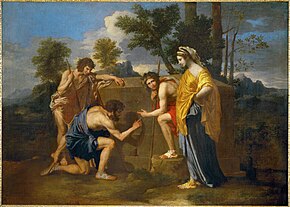Tombeau de Poussin
Tombeau de Poussin ( Poussin's grave ) is the common but misleading name for a no longer existing tomb near the southern French community Peyrolles , often with the alleged secrets about the basis of false assumptions Priory of Sion and Rennes-le-Château is associated .
The tomb
The stone tomb was on a hill fifty meters away from the department road 613 that connects Couiza with Arques , not far from the hamlet of Les Pontils .
It was in the shape of a cuboid , the upper edges of which were beveled, and was erected on a low stone pedestal. The grave was plastered with a layer of cement and had no inscriptions .
The tomb was built in this form in 1933 on behalf of Louis Bertram Lawrence , an American who owned Les Pontils at the time. Before that, there was a simple grave in the ground on the hill. It was laid out in 1903 by Jean Galibert , the owner of Les Pontils at the time, as a resting place for his wife and grandmother. When the Galibert family sold the property in 1921 and moved to Limoux , the bodies were exhumed and transferred to the Limoux cemetery. Lawrence, the new owner of Les Pontils, also took over the tomb and had his grandmother, who had recently died, buried there in 1922. Only after the death of Lawrence's mother in 1931 or 1932 was the stone tomb erected on the hill instead of the simple grave in the ground. This was by no means unusual as private tombs on country roads in southern France are a familiar sight.
The current owner of the site had the tomb completely demolished in 1988 with official approval, because too many people, attracted by the legends surrounding the tomb, entered the property without authorization.
The name Tombeau de Poussin is based on the erroneous assumption that Nicolas Poussin depicted the tomb around 1640 in his painting The Shepherds of Arcadia , possibly combined with hidden references to secret knowledge. Although the grave in the painting actually bears a great resemblance to the tomb at Les Pontils, this theory lacks any real basis, as the real grave was only built in the 1930s and there is nothing to suggest that a comparable structure was previously built on the same Would have existed.
The role of the grave in the Rennes-le-Château myth
Numerous authors who dealt with the alleged secrets that are supposed to exist around Rennes-le-Château , Bérenger Saunière and the Prieuré de Sion , including the hiding place of the Holy Grail , the lost treasure of the Knights Templar and the tomb of Jesus Christ in settle in that area have given the Tombeau de Poussin a place in their theories. The basis for this is mostly the false assumption that Poussin, as an initiate in Secrets, had deliberately depicted this grave and with the grammatically incomplete, but possible in Latin sentence Et in Arcadia ego , which is carved into the stone in his painting, a pointer to the nature of the Want to give a secret or a hiding place. The authors justified their statements in part with complicated analyzes of the picture's content and structure or the alleged finding of complex, hidden geometric patterns in the painting, which supposedly served as geographical clues.
However, since the grave was not built until three centuries later, it can neither have been painted by Poussin nor have been an ancient landmark for a secret hiding place.
Web links
- The Tomb at Les Pontils - The real Truth
- Priory of Sion - Et in Arcadia ego (engl.)
- Nicolas Poussin and the grave at Les Pontils
Literature (selection)
- Richard Andrews, Paul Schellenberger: The last grave of Christ. The geometry of the Holy Grail . 2nd Edition. Lübbe Verlag, Bergisch Gladbach 2005, ISBN 3-404-64167-1 , ( Bastei Lübbe 64167).
- Henry Lincoln , Michael Baigent , Leigh: The Holy Grail and Its Heirs . Origin and Presence of a Secret Order. His knowledge and his power . 12th edition. Bastei Lübbe, Bergisch Gladbach 2005, ISBN 3-404-77002-1 , ( Bastei Lübbe 77002 Stars ).
